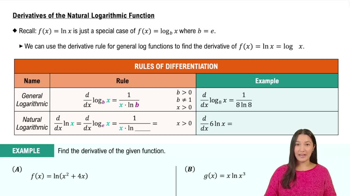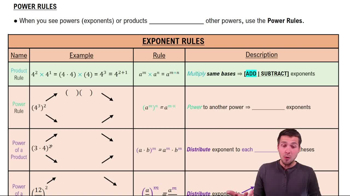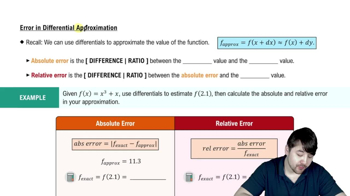Table of contents
- 0. Functions7h 52m
- Introduction to Functions16m
- Piecewise Functions10m
- Properties of Functions9m
- Common Functions1h 8m
- Transformations5m
- Combining Functions27m
- Exponent rules32m
- Exponential Functions28m
- Logarithmic Functions24m
- Properties of Logarithms34m
- Exponential & Logarithmic Equations35m
- Introduction to Trigonometric Functions38m
- Graphs of Trigonometric Functions44m
- Trigonometric Identities47m
- Inverse Trigonometric Functions48m
- 1. Limits and Continuity2h 2m
- 2. Intro to Derivatives1h 33m
- 3. Techniques of Differentiation3h 18m
- 4. Applications of Derivatives2h 38m
- 5. Graphical Applications of Derivatives6h 2m
- 6. Derivatives of Inverse, Exponential, & Logarithmic Functions2h 37m
- 7. Antiderivatives & Indefinite Integrals1h 26m
- 8. Definite Integrals4h 44m
- 9. Graphical Applications of Integrals2h 27m
- 10. Physics Applications of Integrals 2h 22m
4. Applications of Derivatives
Differentials
Problem 4.R.77
Textbook Question
60–81. Limits Evaluate the following limits. Use l’Hôpital’s Rule when needed.
lim_ x→0 ⁺ | ln x | ˣ
 Verified step by step guidance
Verified step by step guidance1
First, recognize that the limit involves an indeterminate form. As x approaches 0 from the right, ln(x) approaches negative infinity, and x approaches 0, creating the form 0^(-∞).
To handle this indeterminate form, consider rewriting the expression |ln(x)|^x as e^(x * ln(|ln(x)|)). This transformation allows us to work with the exponent separately.
Now, focus on evaluating the limit of the exponent: lim_(x→0⁺) x * ln(|ln(x)|). This is an indeterminate form of type 0 * (-∞), which can be addressed using l'Hôpital's Rule.
Apply l'Hôpital's Rule to the limit lim_(x→0⁺) x * ln(|ln(x)|). First, rewrite it as lim_(x→0⁺) ln(|ln(x)|) / (1/x), which is an ∞/∞ form suitable for l'Hôpital's Rule.
Differentiate the numerator and the denominator separately: the derivative of ln(|ln(x)|) with respect to x and the derivative of 1/x with respect to x. Then, evaluate the limit of the resulting expression as x approaches 0 from the right.
 Verified video answer for a similar problem:
Verified video answer for a similar problem:This video solution was recommended by our tutors as helpful for the problem above
Video duration:
6mPlay a video:
Was this helpful?
Key Concepts
Here are the essential concepts you must grasp in order to answer the question correctly.
Limits
Limits are fundamental concepts in calculus that describe the behavior of a function as its input approaches a certain value. They help in understanding the function's behavior near points of interest, including points of discontinuity or infinity. Evaluating limits is essential for defining derivatives and integrals, which are core components of calculus.
Recommended video:

One-Sided Limits
Natural Logarithm
The natural logarithm, denoted as ln(x), is the logarithm to the base e, where e is approximately 2.71828. It is a crucial function in calculus, particularly in growth and decay problems, and is often involved in limits and derivatives. Understanding the properties of the natural logarithm, such as its behavior as x approaches 0, is vital for evaluating limits involving ln(x).
Recommended video:

Derivative of the Natural Logarithmic Function
l'Hôpital's Rule
l'Hôpital's Rule is a method used to evaluate limits that result in indeterminate forms, such as 0/0 or ∞/∞. The rule states that if the limit of f(x)/g(x) leads to an indeterminate form, the limit can be found by taking the derivative of the numerator and the derivative of the denominator separately. This technique simplifies the evaluation of complex limits, making it a powerful tool in calculus.
Recommended video:
Guided course

Power Rules







